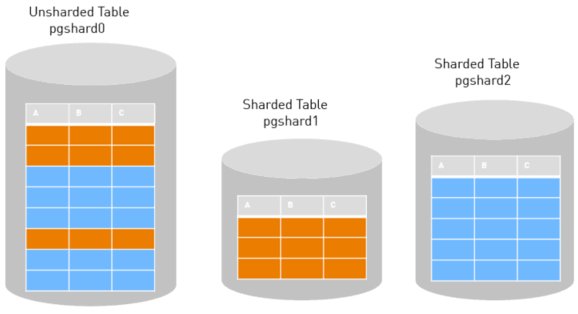“Database sharding is like breaking a large puzzle into smaller, more manageable pieces, enabling improved scalability, performance, and availability, but also requiring careful data distribution, consistency management, and system complexity management.”
Database sharding is a technique used in database management to horizontally partition a large database into smaller, more manageable pieces called shards. Each shard contains a subset of the data and is stored on a separate server or node. The goal of database sharding is to distribute the workload across multiple servers, allowing for improved performance, scalability, and availability.

Sharding and partitioning are both about breaking up a large data set into smaller subsets. The difference is that sharding implies the data is spread across multiple computers while partitioning does not. Partitioning is about grouping subsets of data within a single database instance.
Use Cases of Database Sharding
- Scalable Web Applications: Database sharding is commonly used in large-scale web applications where the database grows rapidly and needs to handle a high volume of concurrent users and transactions. Examples include e-commerce platforms, social media platforms, and online gaming platforms.
- Big Data Analytics: Sharding is used in big data analytics applications where large datasets need to be processed in parallel across multiple nodes to achieve faster query performance and analysis. This is common in applications such as data warehouses, business intelligence platforms, and log analytics.
- Multi-tenant Applications: Database sharding is useful in multi-tenant applications where multiple customers or tenants share the same application, but need to have their data securely separated. Examples include Software-as-a-Service (SaaS) platforms, where each tenant’s data is stored in a separate shard.
Benefits Of Database Sharding
- Scalability: Database sharding allows for horizontal scaling, which means that as data grows, more shards can be added to the system to handle increased load. This enables applications to handle higher levels of traffic and support more concurrent users without sacrificing performance.
- Improved Performance: Sharding can significantly improve the performance of database operations by distributing the workload across multiple servers. This reduces the load on individual servers, allowing for faster data retrieval and processing.
- High Availability: Sharding can provide high availability and fault tolerance. If one shard fails, the data is still available in other shards, reducing the risk of data loss or downtime.
- Cost-effective: Sharding can be more cost-effective compared to vertical scaling, where a single server is upgraded to handle increased workload. Sharding allows for better utilization of resources by distributing the workload across multiple, less expensive servers.
Challenges Of Database Sharding
- Data Distribution and Query Complexity: Sharding requires careful data distribution across shards, which can be complex and challenging to manage. Querying data across multiple shards can also be more complex, as queries may need to be coordinated across shards, which can impact performance and increase the complexity of the application.
- Data Consistency: Maintaining data consistency across multiple shards can be challenging, especially during updates or transactions that involve multiple shards. Ensuring that data is consistent across shards requires careful coordination and management.
- Shard Key Selection: Choosing the right shard key, which determines how data is distributed across shards, is critical for effective sharding. Poor shard key selection can result in data imbalance, uneven workload distribution, and reduced performance.
- System Complexity: Sharding adds complexity to the database management system, including the need for shard management, data migration, and failure detection and recovery. Managing a sharded database system requires specialized knowledge and expertise.
- Application Changes: Sharding may require changes to the application code to support distributed queries and updates, which can be time-consuming and require significant effort.
Final Thoughts
Database Sharding is a powerful technique for improving the scalability and performance of large databases. It is commonly used in web applications, big data analytics, and multi-tenant applications.
However, it also comes with challenges such as data distribution, query complexity, data consistency, shard key selection, system complexity, and application changes, which need to be carefully considered and managed to ensure successful implementation.
🅐🅚🅖
Interested in Management, Design or Technology Consulting, contact anil.kg.26@gmail.com
Get updates and news on our social channels!
LATEST POSTS
- A Tale Of Two Frameworks: Spring Boot vs. Django
 “Spring Boot’s convention over configuration approach simplifies development, allowing developers… Read more: A Tale Of Two Frameworks: Spring Boot vs. Django
“Spring Boot’s convention over configuration approach simplifies development, allowing developers… Read more: A Tale Of Two Frameworks: Spring Boot vs. Django - Unleashing The Power Of Django
 “Django, akin to a Swiss Army knife, provides a comprehensive… Read more: Unleashing The Power Of Django
“Django, akin to a Swiss Army knife, provides a comprehensive… Read more: Unleashing The Power Of Django - Potential of Progressive Web Apps (PWAs)
 “PWAs are not just about technology; they are about creating… Read more: Potential of Progressive Web Apps (PWAs)
“PWAs are not just about technology; they are about creating… Read more: Potential of Progressive Web Apps (PWAs) - Unleashing The Power Of Spring Framework
 “Spring Framework simplifies enterprise Java development, but it does so… Read more: Unleashing The Power Of Spring Framework
“Spring Framework simplifies enterprise Java development, but it does so… Read more: Unleashing The Power Of Spring Framework - Key Trends Of OSINT In 2024
 “The future of OSINT lies in our ability to adapt… Read more: Key Trends Of OSINT In 2024
“The future of OSINT lies in our ability to adapt… Read more: Key Trends Of OSINT In 2024 - Can Google’s Carbon Language Replace C++?
 “While Carbon may excel in performance-critical domains, it cannot replace… Read more: Can Google’s Carbon Language Replace C++?
“While Carbon may excel in performance-critical domains, it cannot replace… Read more: Can Google’s Carbon Language Replace C++? - Integration of Design Thinking, Lean, and Agile
 “Innovation thrives when Design Thinking, Lean, and Agile converge, creating… Read more: Integration of Design Thinking, Lean, and Agile
“Innovation thrives when Design Thinking, Lean, and Agile converge, creating… Read more: Integration of Design Thinking, Lean, and Agile - Benefits Of Infrastructure as Code (IaC)
 “Infrastructure as Code is the single most important thing you… Read more: Benefits Of Infrastructure as Code (IaC)
“Infrastructure as Code is the single most important thing you… Read more: Benefits Of Infrastructure as Code (IaC) - Power Of Internet of Everything (IoE)
 “The true power of the Intebrnet of Everything lies not… Read more: Power Of Internet of Everything (IoE)
“The true power of the Intebrnet of Everything lies not… Read more: Power Of Internet of Everything (IoE) - How Is The Enterprise IoT Evolving?
 “IoT is not just about connecting things; it’s about connecting… Read more: How Is The Enterprise IoT Evolving?
“IoT is not just about connecting things; it’s about connecting… Read more: How Is The Enterprise IoT Evolving? - IT Pricing Strategy And Models
 “The art of pricing lies in finding the perfect balance… Read more: IT Pricing Strategy And Models
“The art of pricing lies in finding the perfect balance… Read more: IT Pricing Strategy And Models - What Is SYCL (“sickle”)?
 “SYCL provides a powerful and intuitive programming model that simplifies… Read more: What Is SYCL (“sickle”)?
“SYCL provides a powerful and intuitive programming model that simplifies… Read more: What Is SYCL (“sickle”)? - What Is A Data Lakehouse?
 “With a data lakehouse, organizations can break down data silos,… Read more: What Is A Data Lakehouse?
“With a data lakehouse, organizations can break down data silos,… Read more: What Is A Data Lakehouse? - 5G – The Future Of The Internet
 “5G is the next big step in the evolution of… Read more: 5G – The Future Of The Internet
“5G is the next big step in the evolution of… Read more: 5G – The Future Of The Internet - Ransomware Groups Are Switching To Rust
 “Rust is to Ransomware what a lockpick is to a… Read more: Ransomware Groups Are Switching To Rust
“Rust is to Ransomware what a lockpick is to a… Read more: Ransomware Groups Are Switching To Rust - Streaming Data Pipelines
 “A streaming data pipeline is like a river: it flows… Read more: Streaming Data Pipelines
“A streaming data pipeline is like a river: it flows… Read more: Streaming Data Pipelines - Why Rust Is Best?
 “Rust is a systems programming language that runs blazingly fast,… Read more: Why Rust Is Best?
“Rust is a systems programming language that runs blazingly fast,… Read more: Why Rust Is Best? - Database Sharding Explained
 “Database sharding is like breaking a large puzzle into smaller,… Read more: Database Sharding Explained
“Database sharding is like breaking a large puzzle into smaller,… Read more: Database Sharding Explained - Ambient Computing Will Be The Future Tech
 “Ambient computing creates a seamless technology-rich environment, but challenges in… Read more: Ambient Computing Will Be The Future Tech
“Ambient computing creates a seamless technology-rich environment, but challenges in… Read more: Ambient Computing Will Be The Future Tech - Key Trends Of OSINT In 2023
 “OSINT is not just a technique, it’s a mindset. It’s… Read more: Key Trends Of OSINT In 2023
“OSINT is not just a technique, it’s a mindset. It’s… Read more: Key Trends Of OSINT In 2023

